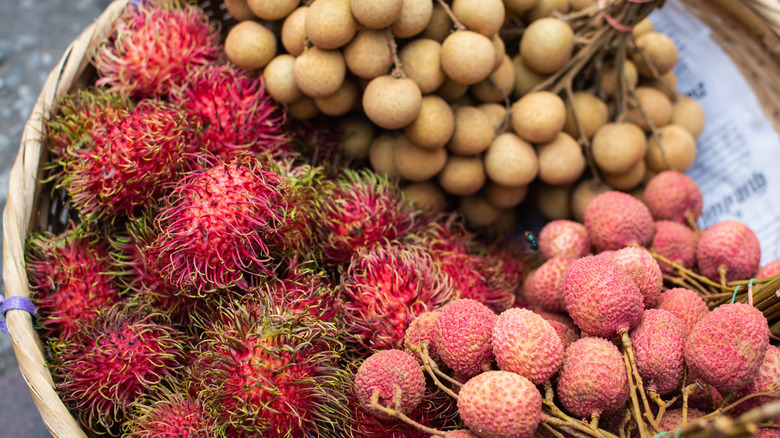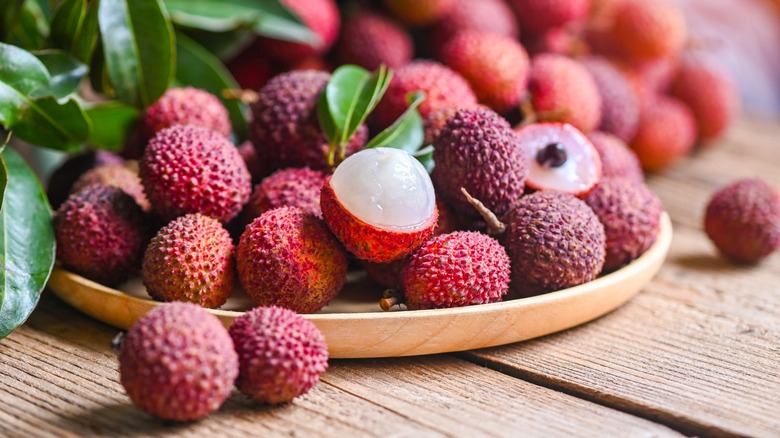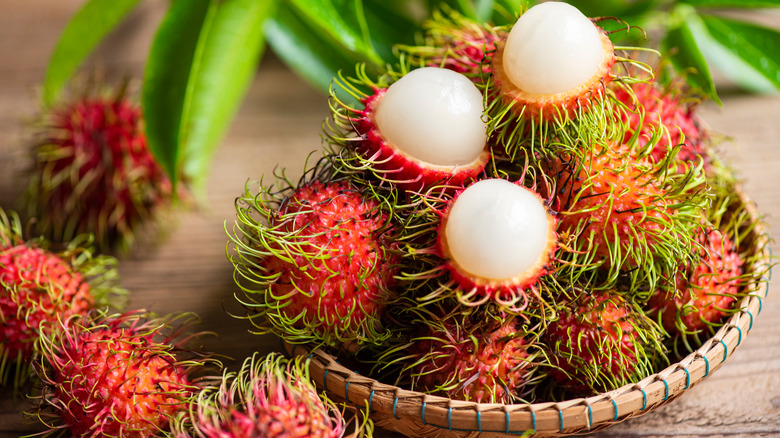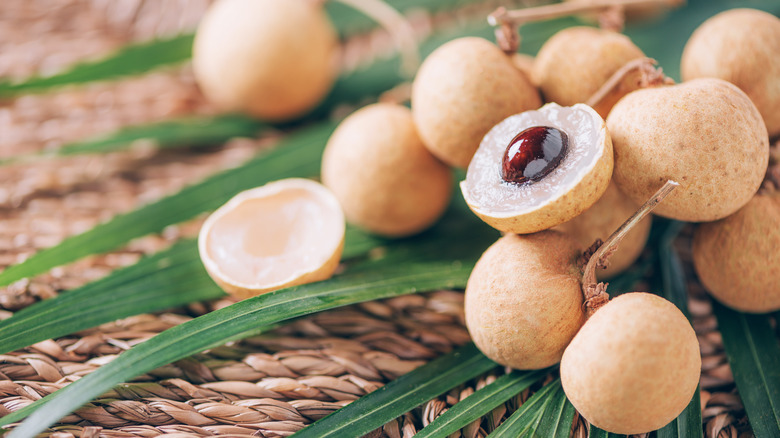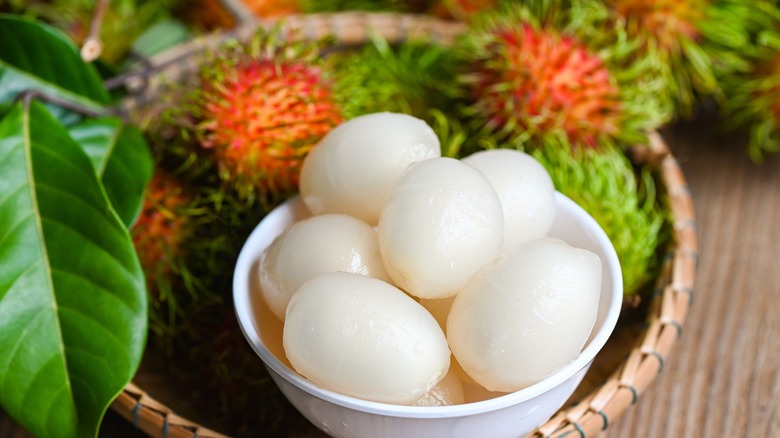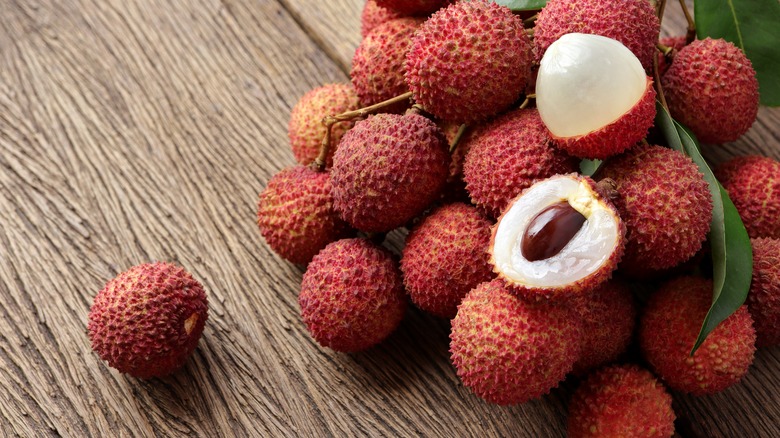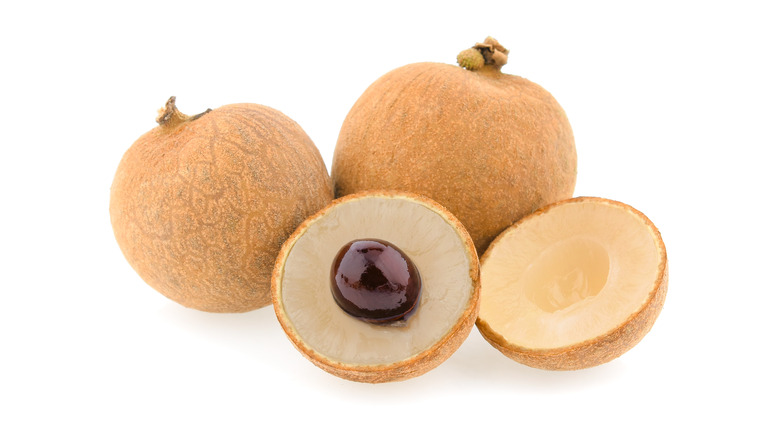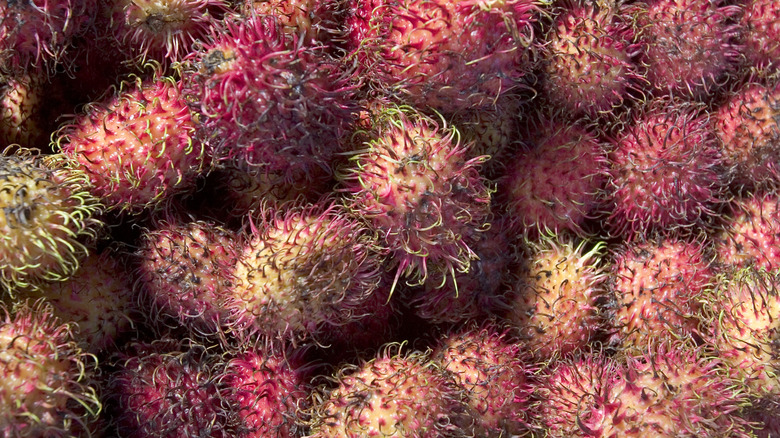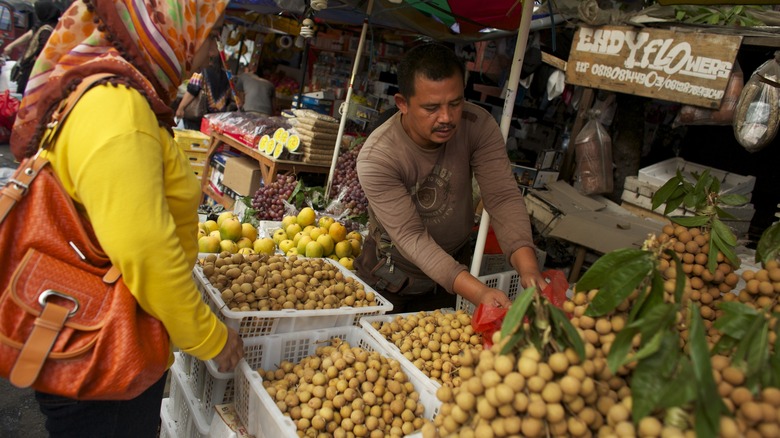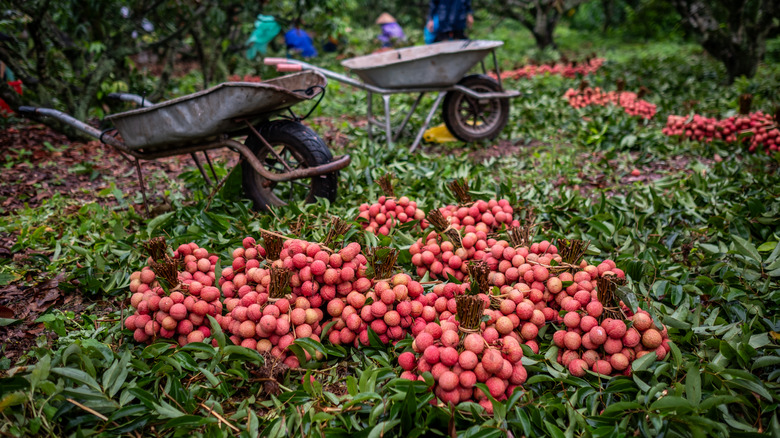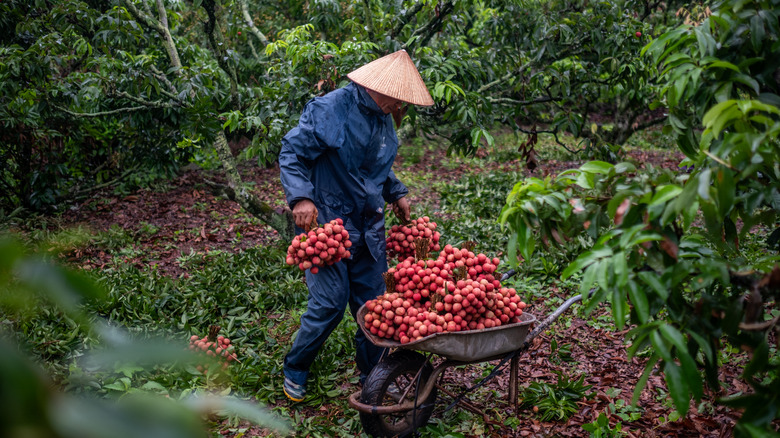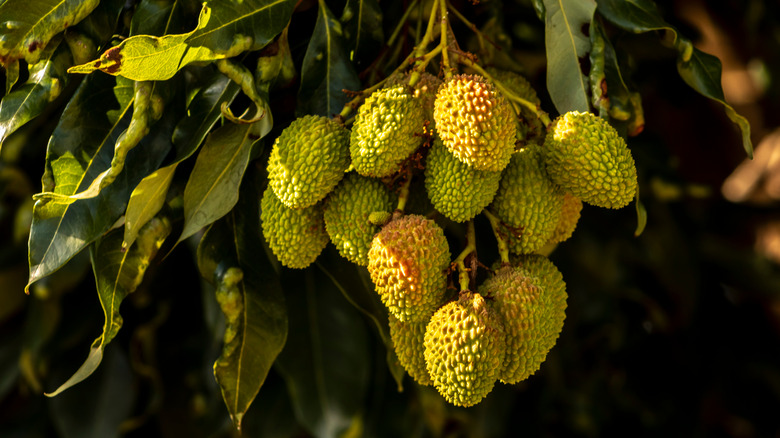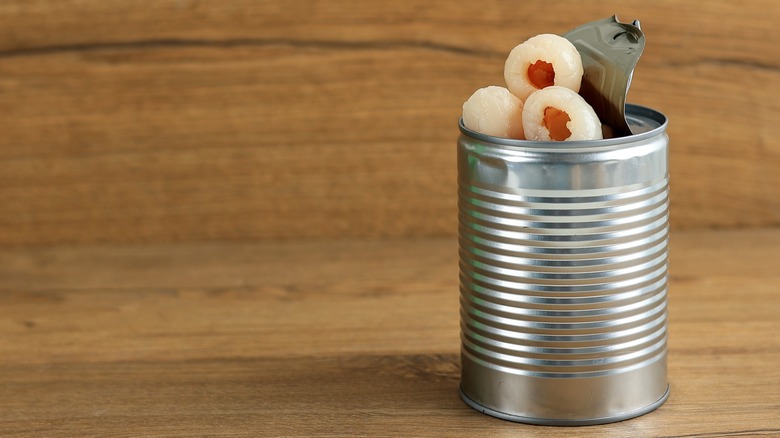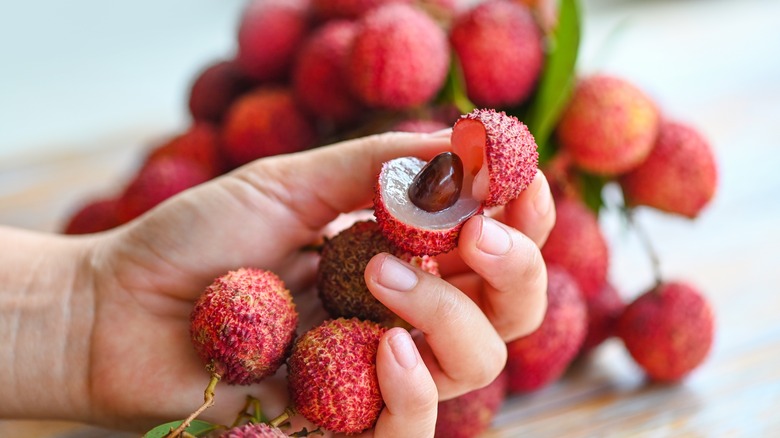Lychee Vs Rambutan Vs Longan: How Are They Different?
In the world of tropical fruits, lychees, rambutans, and longans have a distinctive place. However, since you'll only rarely find them in your local grocery store and usually have to depend on Asian markets and the canned fruit aisle to try them, you might have some questions. They all originally hail from lush tropical landscapes in Asia and have some botanical similarities. However, all these fruits have some key differences, too. So, if you've been wondering which is which and how you might want to seek out, we're ready to help explain the differences.
All three of these unusual fruits are ones you absolutely must try. Next time you run across a bumpy red lychee, a hairy red rambutan, or a tan longan, we want you to know what to expect. Among other things, we'll be explaining differences regarding their origins, flavors, how to use them, when to find them, how to know which to buy, and how long they're likely to last once you procure them. Welcome to the flavorful world of lychees, rambutans, and longans!
What is a lychee?
Lychees are sweet, red fruits that grow in bunches on trees. People compare their taste to a variety of fruits including strawberries. It also has a floral quality. Another name for them is "alligator strawberries," which likely refers to their color, texture, and sweet flavor.
They originated in what's now southern China and northern Vietnam, though today they can be found growing in many parts of Asia, as well as in Brazil, Australia, South Africa, and the U.S.
To eat them, peel the fruit to reveal the white flesh inside and remove the seed. With a texture similar to a peeled grape, lychees make great additions to fruit salads and are fun topping for ice cream. You can also enjoy them in drinks like juice and smoothies. If you find dried lychee, you can even place it into your tea instead of sugar, as some Chinese people do.
What is a rambutan?
Rambutans are otherworldly-looking red (or occasionally yellow) fruits that grow in bunches on trees. Their coating of spikey hair-like growth makes them look a little like a sea urchin. Because of their botanical relationship and similarity in color and flavor to lychees, some people call them hairy lychees. In fact, their name comes from the Malay word for hair (rambut). They're sweet with a little bit of tartness.
Their most likely origin lies in Malaysia and Indonesia. However, they've also been cultivated in Southern China, the Philippines, and Thailand. They also grow in other regions of the world, including warmer areas of the U.S.
To eat them, peel off the order layer to reveal the white, grape-like inside, remembering to also remove the seed. They're common to eat peeled and plain, but they also taste excellent in salads, added to creamy desserts like ice cream and pudding, or even in a warm curry.
What is a longan?
Longans are brown fruits that grow in bunches on trees. They're sometimes called dragon's eyes because of how the black seed and white flesh of the fruit look similar to an eyeball. They have a spicy and musky flavor similar to that of a cantaloupe.
Longans originated in high-altitude areas of southern China. Today, you can find them growing in India, Malaysia, the Philippines, Réunion, Mauritius, and parts of the U.S.
To eat a longan, first peel off the exterior to reveal the dragon's eyeball inside and, just like lycheesand rambutans, take care to remove the seed. You can eat them raw, but some people prefer cooking longans to improve the flavor. A smoky dried version of this fruit is popular, especially when added to drinks. Some also create a longan liqueur by adding smashed raw longans to alcohol and letting the mixture steep for a time.
They're in the same family but belong to a different genus
Lychee, rambutan, and longan are some of the most popular members of the Sapindaceae family, also popularly known as the soapberry family Most of the plants in this family come from tropical or subtropical areas. True to the name, you can turn any of these three fruits into soap since they contain lathering saponin in their skin or seeds.
While they are in the same family, each of these fruits has unique and distinct differences, especially considering that each one is in a different genus. Lychees are part of the Litchi genus, which has three species. Rambutans are in the Nephelium genus, which has five accepted species. Meanwhile, longans are in the Dimocarpus genus, which has eight species.
In many cases, you'll hear these species called lychees, rambutans, and longans even though there is an accepted standard species for each fruit. However, each one is distinct, such as the pulasan, which is related to the rambutan.
They look different inside and out
If you were to peel and remove the seeds of these three fruits, they would all look nearly indistinguishable from each other. However, in their original state, they look very different.
Lychees are about an inch in diameter, are red on the outside, and look like a roughly-textured berry at first glance. Inside, the flesh is white with a glossy, dark brown seed.
Rambutans are the largest of the three, growing one to two inches in diameter. They're usually red like lychees but can be yellow. With a hairy outside, they may look more like a Koosh ball than a fruit. When you open rambutans, you'll find white fruit, while the seeds are a dull tan color.
Longans look the most different from the other two, at least on the outside, where they are a dull light brown color. They also tend to be smaller, at about one inch in diameter. The fruit inside is the same color as lychees and rambutans. However, the seed is glossy and black.
All three fruits have unique flavor
Though they share some similarities when it comes to looks, these three fruits all have unique flavor profiles that set them apart. You'll often hear people compare the flavor of lychees to grapes, pears, strawberries, watermelon, or citrus, among other fruits. Some also detect a distinct if subtle tart edge and a floral, rose-like taste.
Many people find lychees and rambutans to be in the same flavor neighborhood. However, rambutans have a flavor that is more comparable to berries like strawberries, citrus, fresh dates, pears, melons, cherries, and grapes. They're also on the slightly tart side with a floral component and a distinct creamy texture that many diners find to be especially pleasant.
Meanwhile, the flavor of longans is very different from either lychees or rambutans. Some eaters describe them as having an almost spicy flavor like cinnamon and being musky like a cantaloupe.
They exhibit different qualities when ripe
Whether you're plucking one of these fruits straight from the tree or trying to decide which fruit is best to buy in the grocery store, it's a good idea to know when they're ripe. Being able to detect if they need a little more time to ripen or if they're well past their prime can help you have the best experience with these exotic fruits.
Lychees and rambutans turn pink or red when they're ripe, while longans turn tan. The perfect texture for lychees and rambutans is firm but not rock-hard, while longans will be a little more on the firm side. Once they've gone soft and squishy, all three fruits are overripe and won't taste as good.
One way to know if a lychee is ripe is to handle it. When you touch one that's ready for consumption, you will likely notice that it gives off a faint sweet or floral smell. Meanwhile, the hairs of rambutans are helpful in indicating freshness. A ripe rambutan will have soft, supple spines that will get harder and more fragile as the fruit turns overripe.
They have different shelf lives
None of these three fruit have a long shelf life. Lychees dehydrate easily, turning them dull and bland in quick succession. Peeled ones last only a day while refrigerated, while unpeeled ones last about a week. Research published in the American Journal of Food Technology showed that you can increase the fruit's shelf life to 30 days by storing it at 41 degrees Fahrenheit and wrapping it in brown paper and a polyethylene bag.
Rambutans refrigerated between 44 and 50 degrees Fahrenheit will keep for 10 to 15 days. It's also important to keep them in an atmosphere with around 95% humidity so that the hairs and fruit don't dry out. Keeping them at 60% humidity or less shortens their shelf life to 3 to 5 days. However, a study published in Postharvest Biology and Technology found that they kept three to four days longer in an atmosphere comprised of 9% to 12% carbon dioxide.
For the first six days after picking longans, it doesn't seem to matter what temperature they stay. However, they will stay in ideal condition for two weeks at 50 degrees Fahrenheit. Temperatures any warmer or colder shorten the amount of time they stay in good shape.
They're fresh at different times of the year
Given that these three fruits are grown all across the world, they ripen at different times in different countries in concert with the variety of seasons and temperatures they encounter. In the U.S., longans and lychees are in season from late spring when the weather begins warming up to early fall when it starts to cool down. For most shoppers, that's around May to September.
But, if you're looking for rambutans, you will probably have to wait for fall or winter for them to be in season. You'll likely find them available during two different harvest times: August to September and December to January.
All of these times will be when you're most likely to spot these fruits in your local grocery stores. This is also the time when fruit farmers who sell them online can begin to fill your order, so even if you can't find them locally, you may still be able to get them shipped to you.
They originated in different parts of Asia
While all three of these fruits originated in Asia, they developed in different parts of the continent, and sometimes with very different climates. While lychees and longans can handle subtropical climates or higher elevations, rambutans need a much warmer, tropical climate at lower elevations.
The lychee got its start in subtropical southeast China and nearby northern Vietnam, which still grow the most lychees. Longans are also from southeast China but originated in tropical areas with higher altitudes. Hairy rambutans are likely from much farther south in tropical, warm Malaysia and Indonesia. The hairy spines may aid photosynthesis and protect the fruit from predators and might also help the fruit retain moisture while still attached to the tree in a hot environment.
Throughout the years, travelers have brought trees bearing these fruits to areas with similar climates, including warmer regions of the U.S. You can find lychees in India and the Caribbean, while rambutans have spread to Indonesia, South America, and East Africa. They can even be grown in greenhouses in countries without tropical climates.
Lychees have been linked to poisoning cases
In specific circumstances, eating lychees can be deadly. In 2019, scientists realized that the nearly 100 children who died from acute encephalitis syndrome (AES) in India likely acquired it from eating unripe lychees. While AES can spread through viruses, bacterial infections, and parasites, children tested negative for these. India's National Centre for Disease Control theorized that, since these deaths happened during the height of the lychee-picking season, the children had likely eaten too many unripe lychees on an empty stomach (per The Independent).
A 2020 study published in PLoS One indicated that the high level of methylene cyclopropyl-glycine toxins in unripe lychees can cause blood sugar levels to crash, which can be fatal in undernourished children. However, it's worth noting that high levels of pesticides on the fruit also likely contributed to the children's deaths. 2011 was the first known lychee-related AES outbreak in India. Yet, similar tragic lychee-related deaths have happened to children in other countries like Vietnam and Bangladesh.
Rambutans and longans have been responsible for deaths, too, though those tend to be accidents as a result of choking or falling into waterways while picking the fruit. However, some sources indicate that rambutan seeds and skin may be toxic if regularly consumed, though data on human effects is currently scarce (via Healthline).
Not all forms are equally easy to find
Since all three of these fruits can be grown in the U.S., there's a chance that you could find them fresh at a local grocery store, Asian market, or farmer's market. Because of their growing needs, lychees, rambutans, and longans grow best in places like Hawaii, southern Florida, and southern California. Unfortunately, all of these fruits are rather delicate and have short shelf lives, so it's more difficult to transport them beyond their growing area compared to other fruits. Fresh lychees may be the rarest of all, since they have thinner skins that make them more difficult to transport. However, some companies will ship any of these fruits straight to you when they're in season, bypassing the store.
Luckily, there are ways to buy preserved versions of the fruits year-round even if you can't find them fresh. Lychees are the ones you're most likely to see on grocery store shelves or online canned in syrup or as juice, as puree, jelly, or flavoring for candy and other treats. You can find them peeled and in cans as well as dried. Rambutans and longans are a little less popular commercially, so you may have to do more searching and will most often find them canned in syrup or dried.
They have different health benefits
According to Healthline, lychees provide only about 9% of the vitamin C you need for the day. They also contain copper and potassium. A 2009 study published in the Journal of Functional Foods indicates that lychees have weight loss properties, while a 2015 study from the Journal of Ethnopharmacology shows that they may also have antioxidant, cancer-fighting, and germ-fighting properties, among others.
Meanwhile, a small rambutan has as much fiber as an apple and 50% of your daily vitamin C, not to mention copper and other minerals (per Healthline). A 2023 review published in Food Science and Nutrition indicates that rambutans contain antioxidants and may have a role in helping to treat diabetes, cancer, high cholesterol, and allergies, among other conditions.
According to Healthline, longans provide slightly less vitamin C than rambutans but more than lychees at 40% of the daily recommended amount. It's also a good source of fiber and contains a small amount of minerals. A 2012 study published in Evidence Based Complementary and Alternative Medicine indicates that the fruit has antioxidant and anti-inflammatory properties, too.
They have different allergens
Not many people have lychee allergies, but a 1995 study published in Clinical and Experimental Allergy has linked the fruit — and, in particular, the protein profilin — to anaphylactic reactions in some people. However, at least one man without a known profilin sensitivity has had a reaction to lychee. A letter to the editor published in Acta Dermato-Venereologica also indicates that lychees can cause contact dermatitis in some individuals who touch the fruit.
Rambutan allergies are extremely rare, with only four incidences reported as of 2011. Allergists writing in a 1998 issue of The Journal of Allergy and Clinical Immunology believe that a man who had an anaphylactic reaction to the fruit in Thailand may have been first sensitized to the fruit via the plant's pollen A study in the Annals of Allergy, Asthma & Immunology indicates that glyceraldehyde-3-phosphate may be the culprit in some rambutan-related anaphylactic reactions.
Research published in the Annals of Allergy, Asthma, & Immunology uncovered just one case of longan allergy as of 2007. However, the Centre for Food Safety in Hong Kong warns that some people may have allergic reactions to sulfur dioxide used to keep the fruit from browning or becoming diseased.
